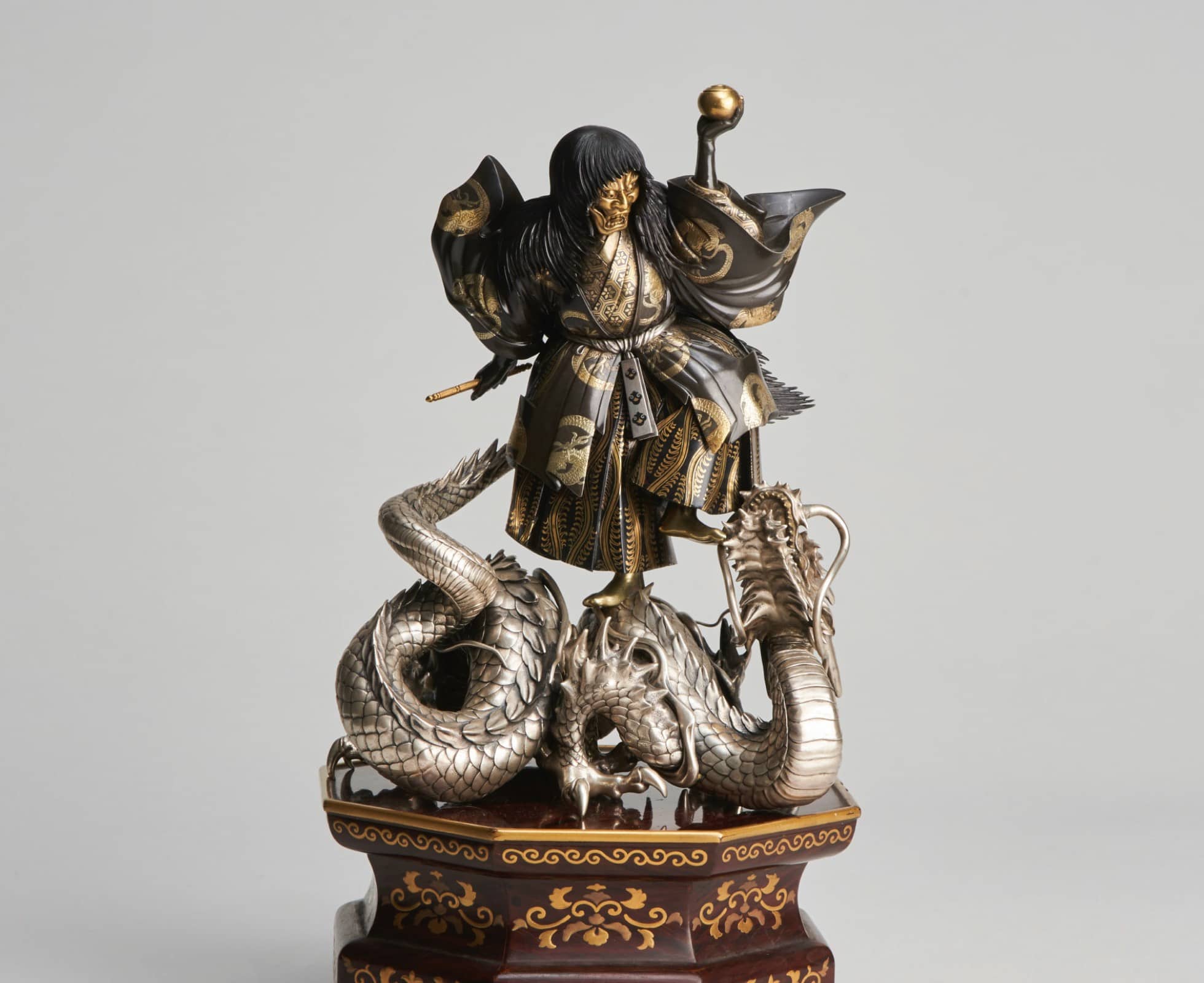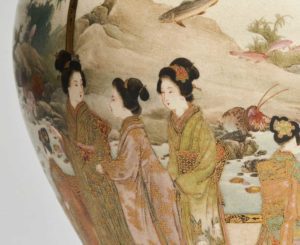The subject of Chinese ceramics is so incredibly vast that we do not claim to be experts in our understanding or academic in our approach. Instead, we prefer to think of ourselves as enthusiasts, privileged to have a large array of fine examples under our care.
Our collection of Chinese ceramics mostly dates from the 18th and 19th Centuries although we do have some wonderful examples dating back to the reign of Emperor Kangxi, (1661 – 1722). Chinese porcelain is a delicate yet resilient, bright white ceramic, so synonymous with its country of origin that in most English speaking countries, we simply refer to it as China.
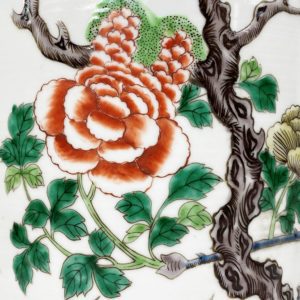
A very brief history of Chinese ceramics
China has an incredibly long and rich history of producing ceramics. Early examples date back more than 20,000 years, (predating Europe by at least 5,000 years.) The Majiayao culture, (3300 – 2200BC) displays an incredibly high level of craftsmanship with fine, thin walls, complex decoration and no sign of imperfections or defects.
One of the most famous, iconic and impressive examples of Chinese pottery is the remarkable Terracotta Army of Xi’an. Discovered by farmers in 1974 it contains more than 8,000 life sized terracotta warriors, horses and attendants, all unique and individual in their design.
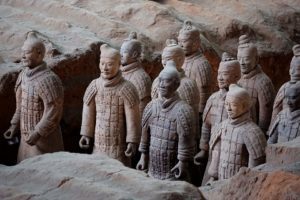
The terracotta army was entombed with the first Emperor of China Qin Shi Huang in 210BC with the purpose of protecting and serving him in his afterlife. It is the largest pottery figurine group ever found and a museum has since been constructed over the area.

The first Chinese porcelain (a Kaolin based clay heated to very high temperatures) is believed to have been made in Zhejiang Province during the Han Dynasty (206BC-220AD). Examples include Hunping (soul jars) often decorated with relief polychrome enamels of phoenix and dragons.
The Tang Dynasty (581-907) followed on from the coloured glaze innovations of the Ha Dynasty and used them to decorate the famous earthenware Tang Dynasty tomb figures that many people today will recognise.
Perhaps one of the most artistically important time periods for Chinese ceramics was the Song Dynasty (907-1276). Items from the ‘Five Great Kilns’ are greatly coveted for their fine glazes and beautiful forms. Good examples from the Song Dynasty consistently fetch extraordinary prices at Auction. In 2017 a perfect bowl reached a staggering $38 million dollars in auction at Sotheby’s.
Many people will be aware of Ming Dynasty (1368-1644) porcelain. It was an age of great innovation with the development of many new forms, colours and glazes. The Ming Dynasty also marked the start of China’s export empire with porcelain leaving China for all corners of the globe via the Silk Road.
Families and types of Chinese Porcelain
There are many styles of export Chinese porcelain. Generally, they are grouped into families or categories by colour or subject. We have written a useful (and brief) summary of some of the most commonly sought after groups:
Blue and White:
Classic and simple. Blue glaze on a white ground. There is a huge array of subjects and patterns with some of the most popular featuring figures in battle, rural and village scenes, dragons, blossom, flora and fauna.

A stunning QianLong blue and white vase
Famille Rose:
Normally on a white ground, with delicate pink floral decoration. The pink colour will often feature in other areas of the decoration, (figures, clothing, creatures, borders etc.)

This pair of 19th Century vases are a great example. See more here.
Famille Verte:
A palette of mainly green colours often with orange and blue highlights. This pair of 19th Century vases is a great example of Famille Verte style with different shades of greens alongside vibrant oranges and blues. See more here.
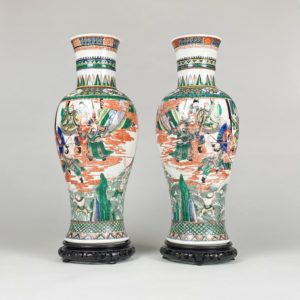
Canton:
Canton or Cantonese is a style of porcelain decoration produced in Guangzhou, Guangdong from the early 19th Century onwards. It is typically decorated with panels of figures, birds and insects on complicated grounds usually in palettes of green and pink, gold and blue. This stunning punch bowl, (59cm across) featured in the Financial Times in 2020. See more images here.
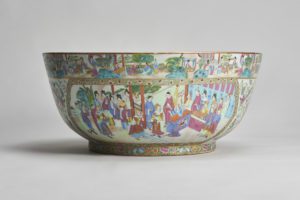
Powder Blue
Powder blue is a glazing technique that originated in the Ming Xuande Period (1425-1435). The cobalt blue would be blown through a tube with gauze on the end, (not dissimilar to airbrushing) onto unglazed porcelain it would then be glazed and fired, creating a mottled blue effect. Powder Blue ground is often accompanied with gold decoration to create a striking effect.
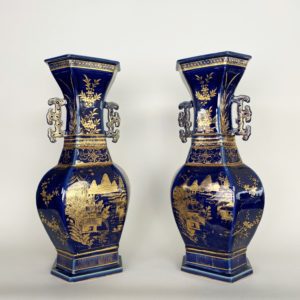
A recently sold pair of dramatic 18th Century Powder Blue vases
Monochrome
These are vases of one solid or graduated colour. Common and famous examples include Sang de boeuf (Ox blood) and simple black vases.
This pair of 19th Century black Monochrome vases are a great example and you can see more by clicking here.

Wucai (Five colours)
Five colours’ uses a limited range of colours on a white ground. Decoration often has images of figures or animals and it can be seen as the precursor to famille verte.
The colours that normally feature are blue, green, orange, yellow and white.) This pair of early 19th Century jars are a great example. Click here to see more
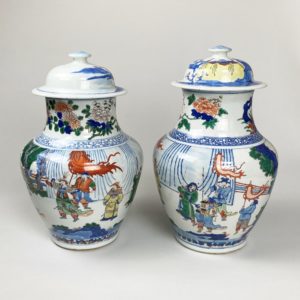
Clobbered
Another really interesting subject, the term “clobbered” or “clobber ware” refers to Chinese export porcelain that has had its original blue and white under glaze added to at a later date usually with coloured enamel decoration. The practice originated in Holland and spread through Europe.

Other groups of Chinese export porcelain include Tobacco Leaf, (inspired by Indian textiles and dating from 18th Century onwards, tobacco leaf features large bright coloured leaves.) Cabbage Leaf, (often used for dinner services and depicting large cabbage leaves along with flowers and butterflies) and Shipwreck Porcelain (salvaged ceramics from ancient ship-wrecks) but we don’t really deal in these.
Marks and “signatures”
The subject of “Marks” on Chinese porcelain is incredibly complex but we will try to provide a top-level summary in just a few lines. There are actually relatively few marks and they usually simply describe the reign of a specific Emperor. It is incredibly rare to have a historic Chinese ceramic with the signature of an actual artist. Unfortunately, the name of the Emperor that appears on an object doesn’t necessarily help to date the piece. Not all pieces marked are of the time-period they appear to be. This doesn’t mean that they are fakes. In historic China, items imitating the style of a previous ruler may be marked with that seal in order to honour the previous Emperor. This was well known and accepted at the time and was by no means, an attempt to be dishonest or misleading. The term “mark and period” means that a piece is identified as having the correct reign mark of the period in which it was made. A further consideration is that not all imperial standard pieces were marked with a seal. It is possible for pieces to be unsigned and of imperial standard.
Confusing, isn’t it?
If you are not sure, we would recommend showing your piece to a good, reputable auction house as they should be able to reassure you if a piece is Mark and Period.

The mark of Emperor Qianlong (1736 – 1795), on the base of a pair of 19th Century Wucai jars.
What else to look for:
Perfect examples of Chinese porcelain and Mark and Period pieces regularly and consistently fetch incredibly high prices in auction so, if you are looking to buy a piece for a private collection or simply to enjoy at home or in the work-place, it may be better to look for pieces with a small amount of damage or minor restoration.
Considering the age of antique Chinese porcelain and that it will likely have travelled thousands of miles on more than one occasion, it is almost to be expected to find some wear and damage. All antique Chinese porcelain will have been originally made by hand so even matching pairs are likely to have minor differences and there may be some flaws in the original firing that are not to be regarded as damage. Firing cracks should be seen more like birth-marks than damage.
In time, “perfect” pieces will become incredibly hard to find, but the appetite to acquire authentic Chinese porcelain will continue to grow so pieces with minor damage and sympathetic/honest restoration could represent sound investment opportunities.
Here are a few things (and commonly used terms) to look out for in terms of damage and restoration:
Frits: Small nibbles of glaze and body of the piece breaking away around the edges, often seen on the rims of vases, plates and teacups.
Glaze Flaking: With age and sometimes use the glaze of an item can sometimes become brittle and flake away taking decoration with it, these are fairly easy to spot with the naked eye or by running your fingers over a piece.
Hairline Cracks: Incredibly fine cracks (named after the width of a strand of hair) can be hard to spot, especially if they are recent. Tapping the body of an item can be a helpful indicator. If there are no hairlines it will make a ‘ringing’ noise, if it makes a dull noise it is likely to have hairline cracks for that such imperfections have been restored.
Pieces Missing: Generally, fairly obvious to spot. If a missing piece is present (albeit not as present sa it should be), it may be possible to put it back with the help of an expert restorer.
Restoration:
Good restoration, when done to a very high quality can be very difficult to spot, even to the trained eye. As well as returning the piece to its original aesthetic, it can also help to stabilise the integrity and physical stability of the piece.
There are different types of restoration to consider:
Museum restoration: Normally the restoration has been done very well but the restorer will make no attempt to hide the work that has been done. If a piece is missing, it will be filled with plain clay so you can see cracks where it has been glued back together.
Amateur restoration: Using materials like super glue is, unfortunately, common and rarely done well. It is possible and likely to cause further damage so we strongly advise not to attempt amateur restoration on a piece of any real value.
Very old restoration: You will sometimes see large metal staples on objects such as jardinieres and larger vases. This normally means that the restoration work was done not long after the piece was first made. This can actually be desirable as it proves age and displays an extra form of historic skill and craftsmanship.
We do have some pieces in our collection that have damage or have been restored (to a very high standard). We will always ensure that this information is transparent and when we have worked with a restorer, it will have been done to the highest possible standard.
We hope that this has been an interesting read. You can browse through a selection of our collection of antique Chinese Porcelain by clicking here
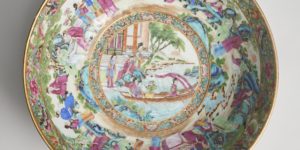
For a similar read, you can see read “The Satsuma Story“. Our short history of the popular Japanese earthenware pottery.

